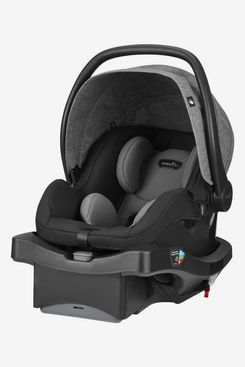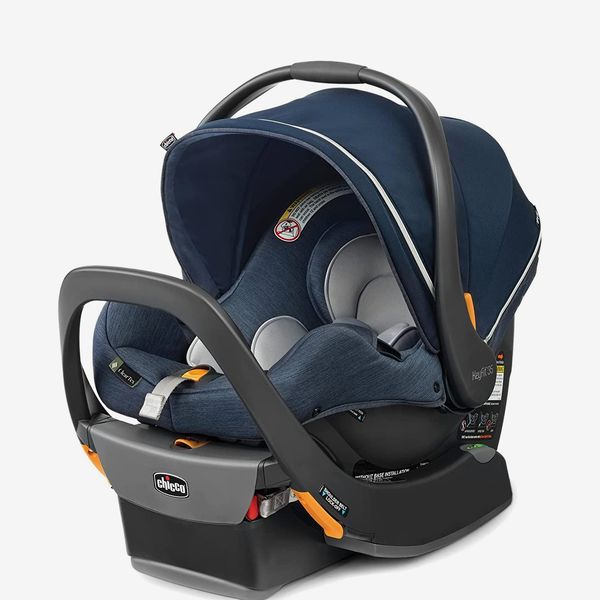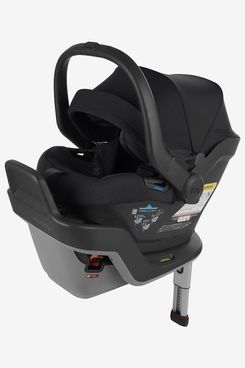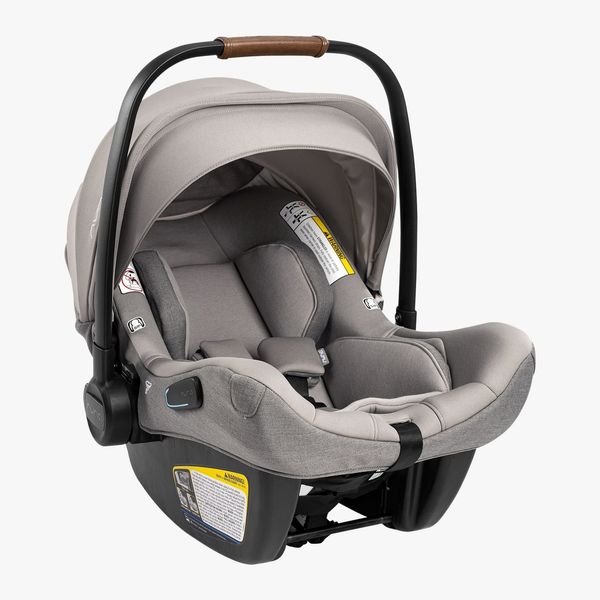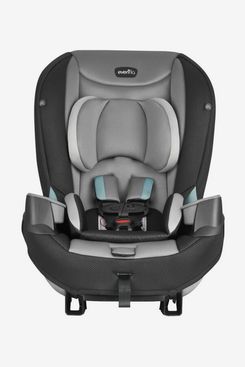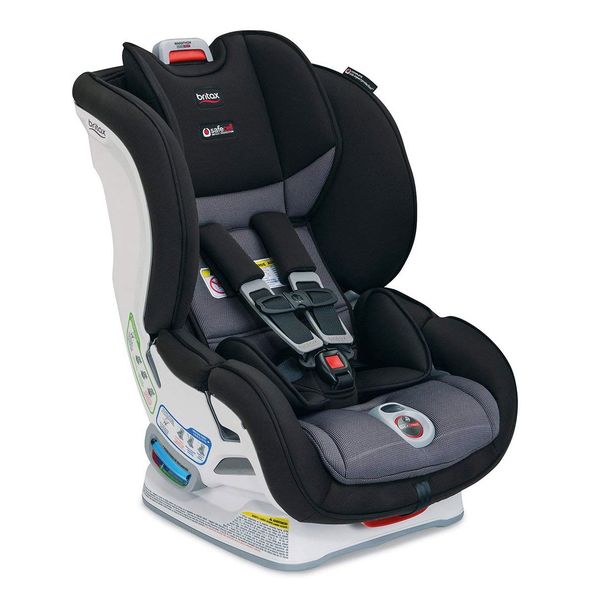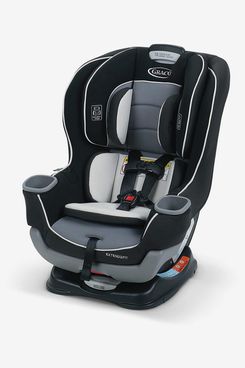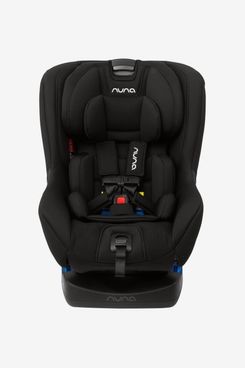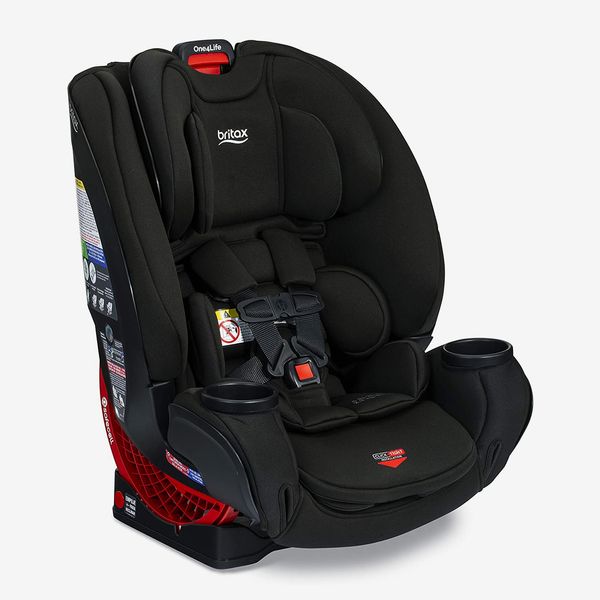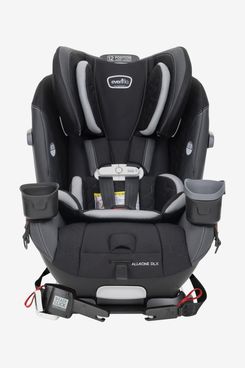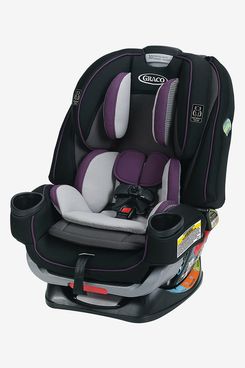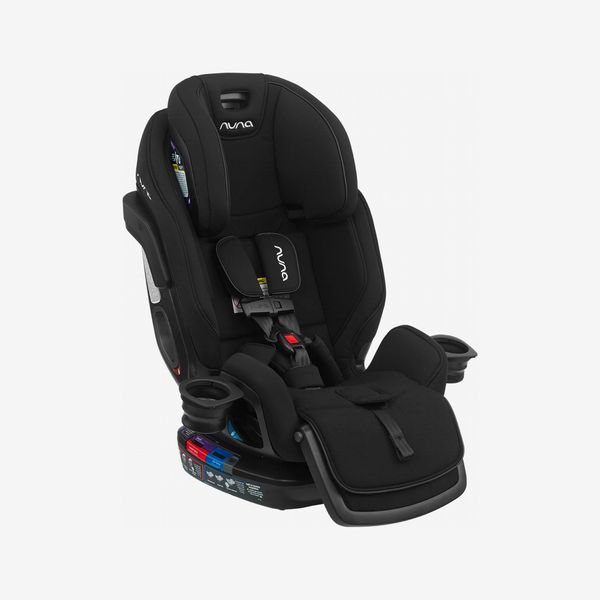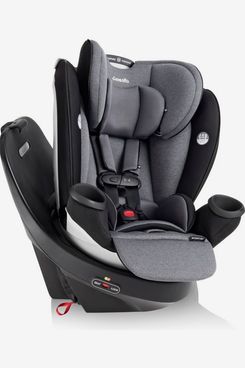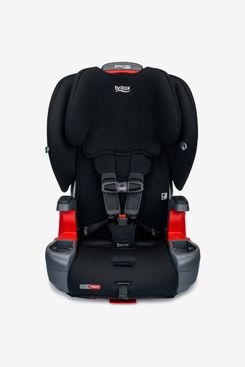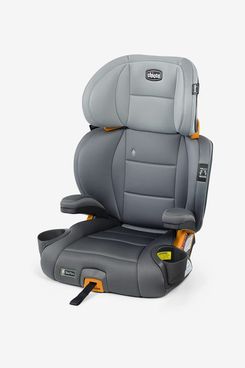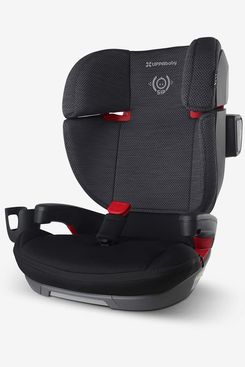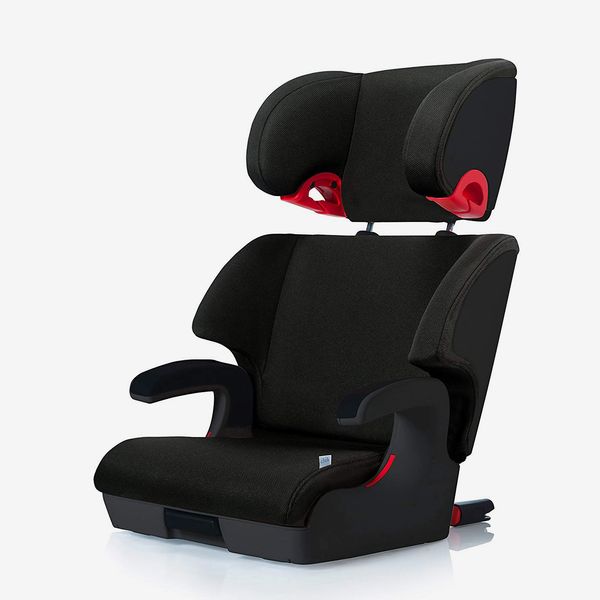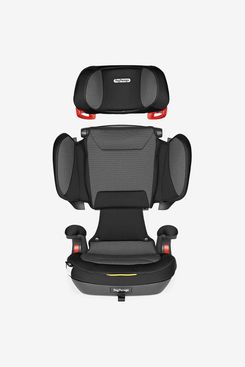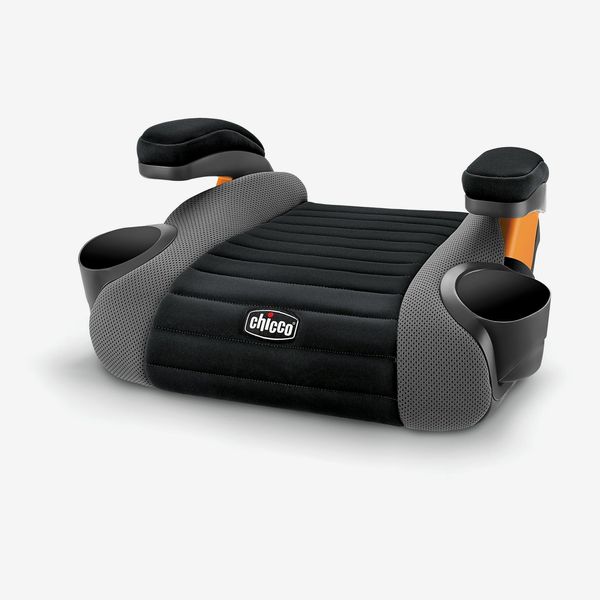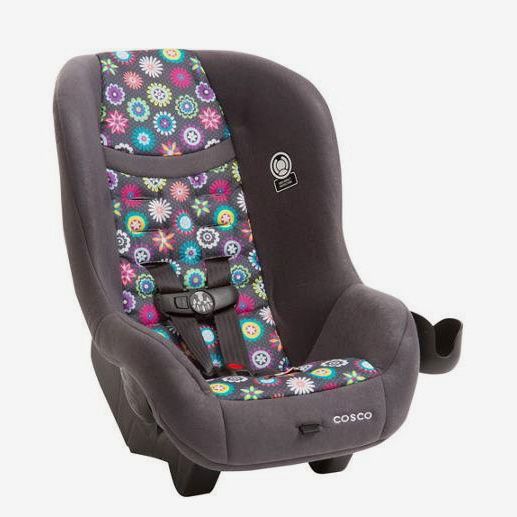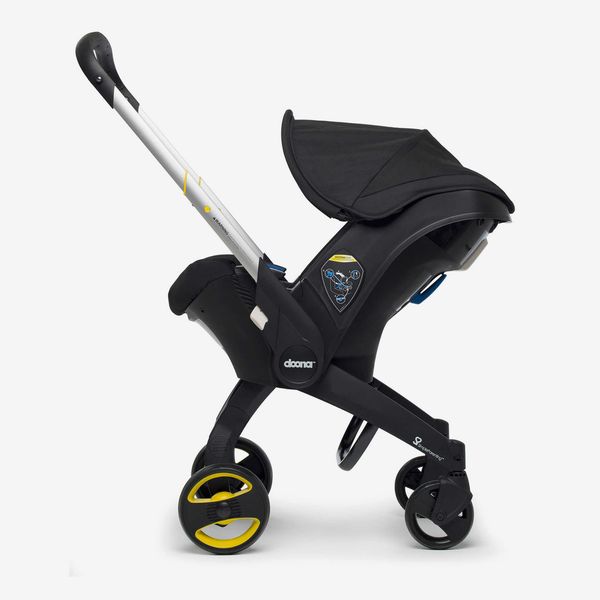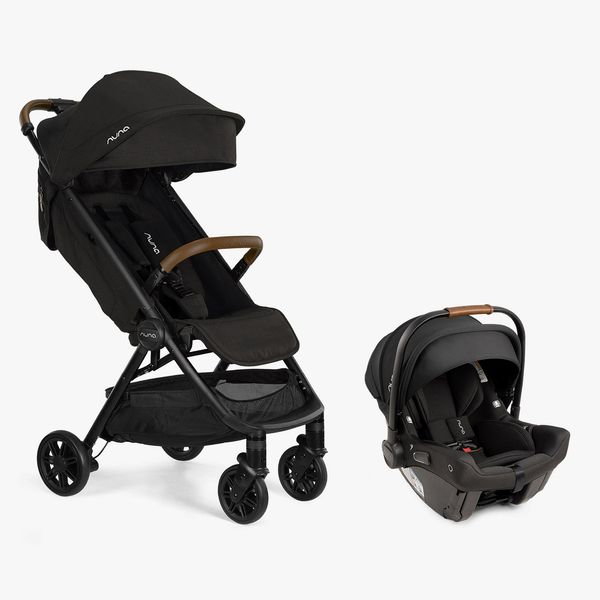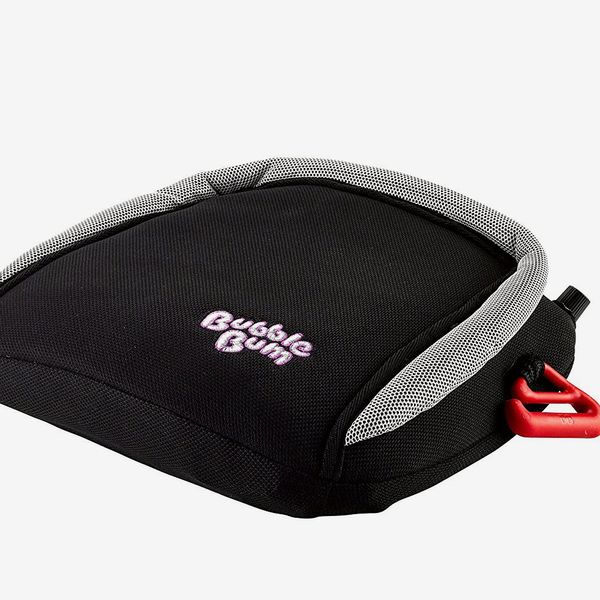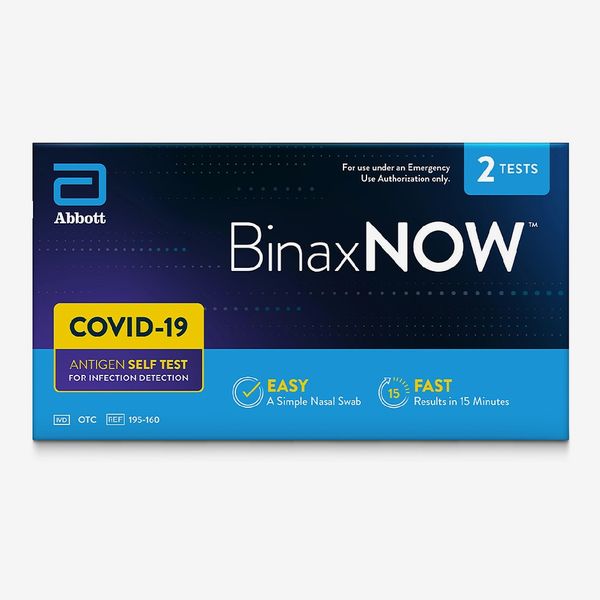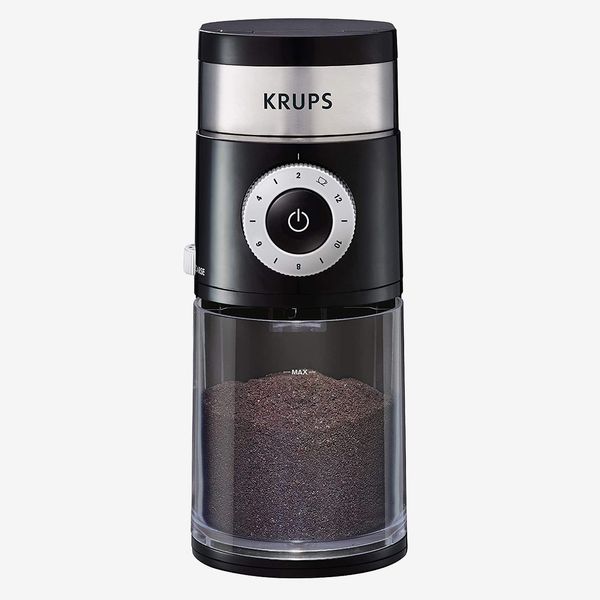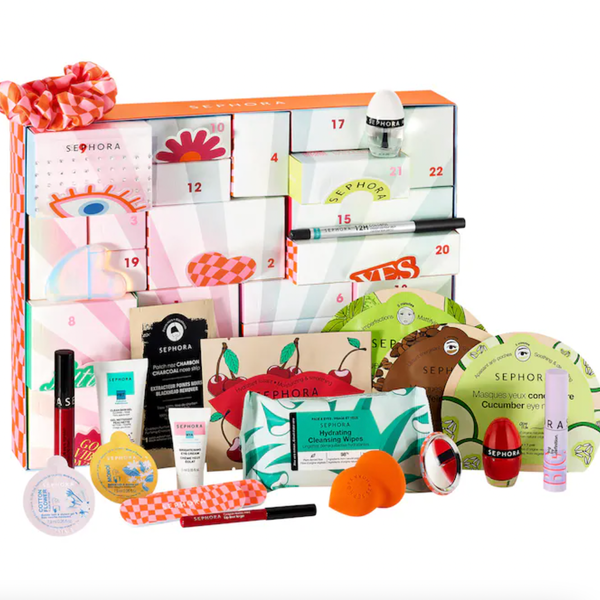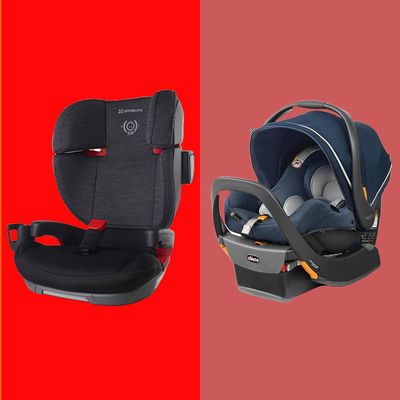
Jump to section
Navigating the complex and endless world of baby gear — from strollers to high chairs to cribs — can be a bit overwhelming, and car seats are no exception. All car seats in the United States have passed the same rigorous safety-testing standards, so they are, at minimum, equipped to protect your child during a crash. But with hundreds of seats on the market, you’ll need to narrow your options somehow.
Ultimately, “the best car seat for any child and family is the car seat that fits the child, fits the car, and that the family will be able to use correctly every time,” says Ben Hoffman, a pediatrician who helped write official American Academy of Pediatrics policies on child-passenger safety.
The National Highway Traffic Safety Administration (NHTSA) provides a guide to help you figure out which type of seat you need. You’ll want to focus on four main factors: your child’s age, weight, and height; the car you drive; the convenience features that are important to you; and, of course, your budget. (If you have multiple children in car seats, you’ll also need to make sure each seat fits in your car when installed according to manufacturer instructions, as some are not narrow enough to sit side by side.)
To help you get started, we asked experts and parents for recommendations in each category of car seat — infant, convertible, and booster — that would fit a variety of vehicles and budgets, plus make installation smoother and safer. Because there’s no one-size-fits-all option, we’ve formatted this post a little differently than usual: Instead of naming a best overall pick, we broke the choices down into age groups and types of seats.
What we’re looking for
Max weight and height
“From a safety perspective, we recommend that kids stay in the safest car seat until they outgrow it,” says Jennifer Saxton, the founder of Tot Squad and a child passenger safety technician. “Don’t try to move your kid too quickly to the next car seat.” In other words, children should max out the weight or height limit of their current car seat before moving to the next stage. The exact laws around car seats and when a child must be rear-facing vary by state, but all of the experts we talked to agreed that the longer you can keep your child in a rear-facing position, the safer they will be. We listed the maximum weight and height limit of each seat, below. For car seats that can be used in multiple positions (rear-facing, forward-facing, booster), we listed the weight limits for each.
Seat type
There are five major types of car seats:
Infant (or bucket): As the name suggests, infant seats are designed to be used from birth, with most having a weight limit of 35 pounds. They can only be used in a rear-facing position and typically come with a base that is installed in your car, allowing you to easily click the bucket seat into and out of it. Bucket seats can double as infant carriers, and most can be attached to a stroller or a stroller frame (though you may need a special adapter). For this reason, considering the weight of the actual seat is a good place to start, as it will only get heavier as your baby grows.
Convertible: Convertible car seats are designed for use from birth through toddlerhood. They can be used rear-facing or forward-facing, and the switch is typically made when your child maxes out the height or weight limit of the rear-facing mode. If you don’t care about using your car seat as an infant carrier, you can choose to skip the bucket seat completely. The main trade-off is that you’ll save money on replacing a bucket seat when they outgrow it (around age 1, on average), but you’ll lose the convenience of easily transferring your baby from the car to their stroller or into your home without having to remove them from their seat.
All-in-one: All-in-one car seats are convertible seats that can also be used in booster mode, allowing some kids to use them up to age 10. Their one-and-done quality is their main appeal: Instead of buying two or three separate car seats over the course of your child’s first years, the thinking is that you can buy just one and save money in the process. However, once you get to the booster stage, they will be bulkier in your back seat than a high-back booster. And if you’re going to use one car seat over the course of ten years or so, you should expect to do some work to keep it clean.
High-back booster: Booster seats are made for children who have outgrown their harnessed seat but aren’t tall enough to safely use a regular seat belt. “Seat belts and cars are designed for adults four feet nine and taller. So if they’re four-feet-nine or shorter, the seat belt is not going to fit the child’s body safely. In particular, the lap belt of a seat belt, instead of going across the bony hips of an adult, is going to go across the belly of a 4-year-old instead,” explains Eli Gurock, founder and CEO of the baby-gear and toy-retailer Magic Beans. Booster seats literally give your child the boost they need to ensure proper seat-belt placement, and high-back boosters have more structure around the head and shoulders to position the shoulder belt, give your child a place to rest their head, and minimize forward head movement and whiplash in the event of a crash.
As a general rule, children should weigh at least 40 pounds and be 40 inches tall before riding in a booster seat with just the seat belt. However, age and size are not the only factors that determine a child’s readiness for a booster seat. Alisa Baer, pediatrician and co-founder of thecarseatlady.com, says parents and caregivers should also consider their child’s maturity and ability to sit in a booster without slouching, leaning, or yanking on the seat belt. NHTSA points out that most kids will need to use either a high-back or a backless booster until they are between 8 and 12 years old.
Backless booster: The function of backless boosters is the same as high-back boosters — to raise the child’s body and ensure proper seat-belt placement — but they are much lower profile and more portable. They usually have the same weight and height restrictions as high-back boosters and work best for older kids who still need to use a booster but are reluctant to be seen as babyish, or as a space-saving option to keep in your trunk for carpooling. They are also travel-friendly.
Extra safety and specialty features
In the United States, every car seat on the market must pass strict Federal Motor Vehicle Safety Standards (FMVSS) — so as long as a seat fits your child and your car, your choice really comes down to any additional safety features you’re looking for as well as convenience and comfort features. Parents may appreciate simple installation, a rotating feature that makes it easier to get a child into the seat, a no-rethread harness, or an extended rear-facing weight limit. Children may benefit from extra cushioning, cupholders, and extended footrests. We’ve highlighted the notable safety and convenience features of each of the car seats in our list.
Rigid LATCH vs. Flexible LATCH
LATCH is a system that allows you to secure your car seat or car-seat base to your vehicle without using a seat belt — it’s an acronym for Lower Anchors and Tethers for Children. With the exception of a few boosters on our list, the seats we recommend below have either rigid or flexible LATCH connections. Rigid LATCH uses alligator-like clips that come directly out of the car seat or base without any straps or rotation. They allow for a more secure hookup that is not dependent on your ability to pull the belt strap tightly. Flexible LATCH connectors are attached to a pull strap that can be tightened or loosened, either by hand or, depending on the seat, with some type of tightening mechanism. Both options are safe and meet FMVSS requirements, but rigid LATCH is easier to install and doesn’t require any manual tightening or adjusting, ensuring correct installation. In the event of a crash, rigid LATCH also helps keep the car seat from sliding forward or side to side.
Price
There are four price points we decided on, denoted as $, $$, $$$, and $$$$, respectively: under $200, under $350, under $500, and over $500.
Best infant car seats
Max weight and height: 35 pounds, 32 inches | Features: Load leg, cooling mesh fabric | LATCH: Flexible | Price: $$
If you’re looking for a budget-friendly infant car seat, Babylist gear editor Jennifer LaBracio recommends Evenflo’s LiteMax DLX. “It’s consistently a top pick among child-passenger safety technicians for a safe, affordable infant seat,” she says. “It has a lot of features that are only found in much more expensive seats, like a load leg — which in a seat that’s a couple hundred dollars is a huge bonus.” According to Gurock, load legs offer added safety by stabilizing the car seat “to keep it from rotating in the instance of a crash.” The seat without the base weighs just under nine pounds, which LaBracio says is “really light” for an infant car seat.
Max weight and height: 35 pounds, 32 inches | Features: Anti-rebound bar, full-coverage canopy, quick-remove seat pad | LATCH type: Flexible with SuperCinch | Price: $$
The Chicco KeyFit line of infant seats is an established favorite among the parents and experts we’ve surveyed. “It’s so darn easy to install,” says CPS technician instructor Kecia Healy, who is also a member of the New York State Child Passenger Safety Advisory Board. The base of the seat has a spring-loaded recline foot and bubble indicator to help get it perfectly level. The flexible LATCH connectors also have Chicco’s SuperCinch tightening system to ensure a secure fit. Allyson Downey, who runs a consumer-review site for child and baby essentials called WeeSpring, says that for her first child, she bought a Chicco KeyFit after doing extensive research. “It had outstanding reviews,” she says. Lauren Brown, Mt. Washington Pediatric Hospital’s lead car-seat-safety specialist, says the seat is also a popular choice among parents she works with, and Saxton calls it a “tried-and-true, solid car-seat choice.” This Chicco Keyfit 35 Zip ClearTex seat is the latest addition to the Keyfit line and features GREENGUARD Gold–certified materials, a fully extendable canopy, an anti-rebound bar for added stability, a no-rethread harness, and a “quick-remove” seat pad for easier cleaning.
Max weight and height: 35 pounds, 32 inches | Features: Load leg, anti-rebound panel, red-to-green installation indicators | LATCH type: Flexible | Price: $$$
Statusy Uppababy seats are another popular choice, especially among those who want a seat that is easily compatible with their stroller. This Mesa Max seat, released in 2022, is a newer version of a seat we previously recommended. Gurock likes that it has a load leg on the base, and Mei Ling Starkey of the blog Family Entourage appreciates the no-rethread harness: “You pull the tabs to tighten it and the harness slides right down. You can put a tall child in it one day and a tiny, tiny child in it the next day and get a perfect fit.” The base has a flexible LATCH system and a red-to-green indicator that lets you know it is secure. It also clicks directly into Uppababy’s Vista and Cruz strollers as well as into the brand’s more compact Minu stroller with adapters.
Max weight and height: 32 pounds, 32 inches | Features: Load leg, anti-rebound panel, push-button recline, full-coverage canopy | LATCH type: Rigid | Price: $$$$
Both LaBracio and Gurock say that the Nuna Pipa Lite RX is not only a premium choice thanks to its added safety features of a load leg and an anti-rebound panel, but because it’s incredibly light, weighing just 6.9 pounds without the base. It’s “super-easy to carry, especially as your baby gets older and heavier,” LaBracio says. It’s made of GREENGUARD Gold–certified materials and has upscale touches like an organic merino-wool infant insert, a faux-leather-wrapped handle, and magnets on the side that hold the no-rethread harness out of your way when you’re getting your baby into or out of the seat. It also has a push-button recline and color-coded locking indicators on the rigid LATCH connectors and load leg that let you know it is tightly and properly installed.
Best convertible car seats
Max weight and height: (Rear) 40 pounds, 50 inches (Forward) 65 pounds, 50 inches | Features: Compact frame, cupholders | LATCH type: Flexible | Price: $
Healy’s pick for an affordable (but basic) convertible car seat is the Evenflo Sonus 65, which has a rear-facing weight limit of 40 pounds and a forward-facing weight limit of 65 pounds. It also has a compact frame, allowing you to install three of them across the back seat of most midsize vehicles. “It doesn’t have many bells and whistles, but for just a little more than $100, if you are looking for a spare seat for a second vehicle or a seat that you can travel with” it’s a good choice, says Healy. She adds it’s worth noting that Evenflo car seats require children to be at least 2 years old to ride forward-facing.
Max weight and height: (Rear) 40 pounds, 49 inches (Forward) 65 pounds, 49 inches | Features: ClickTight installation system, add-on anti-rebound bar | LATCH type: Flexible | Price: $$
“I swap my car seats from car to minivan, and the extreme simplicity of the ClickTight system is the feature,” says Kenny Fried, the vice president of Brotman | Winter | Fried. “Instead of having to thread the seat belt behind the seat, you lift the inside seat up on a hinge and then pull the seat belt over and click in the seat belt. Takes about 30 seconds to install.” The ClickTight system eliminates needing to pull, tug, and lock your seat belt in place because it has an automatic tension mechanism for a snug fit. And if you want even more protection in a crash, you can invest in an attachable anti-rebound bar from Britax that works with its convertible car seats in rear-facing mode; it’s another feature Hoffman recommends for reducing movement during crashes.
Max weight and height: (Rear) 50 pounds, child’s head one inch below handle (Forward) 65 pounds, 49 inches | Features: Extended rear-facing weight limit, extendable legroom panel, cupholders | LATCH type: Flexible | Price: $$
LaBracio loves Graco’s Extend2Fit convertible car seat and calls it a “really good value.” She likes that it has a high rear-facing weight limit of 50 pounds (with a forward-facing limit of 65 pounds), plus it’s “easy to install, and it’s also a great fit for almost any type of car.” It also has a no-rethread harness, two cupholders, and an adjustable extension panel that provides extra legroom to keep taller children comfortable while rear-facing (as long as there’s enough space in your car to use it). The Extend2Fit line also includes a 3-in-1 version that converts to a high-back booster, and an all-in-one version that converts to both a high-back and a backless booster.
Strategist senior editor and mom of two Jen Trolio used different versions of the Graco Extend2Fit for both of her daughters, who are now 5 and 8 years old. She originally chose the seat because it fit well rear-facing in the back seat of her Mazda sedan. Each kid used their Extend2Fit from about one year old to 5 years old. Although one of the Extend2Fit models Trolio owned could also be used as a booster, Trolio ultimately replaced it with a Chicco high-back booster because the Extend2Fit was bulky and made it difficult for her older daughter to buckle herself in.
Max weight and height: (Rear) 50 pounds, 49 inches (Forward) 65 pounds, 49 inches | Features: Extended rear-facing weight limit, push-button leveler, extendable legroom panel | LATCH type: Flexible | Price: $$$$
Gurock says the Nuna Rava is one of the most popular convertible car seats his store sells because it has supreme safety and convenience features — like a reinforced steel frame — plus an overall sleek and stylish look. Designed to make installation easy and straightforward, the seat’s “Simply Secure” system has a bubble-free leveler that uses a simple push button so you can find the correct angle effortlessly. And if you’re not using LATCH, the color-coded belt paths indicate the proper way to thread your car’s seat belt. Like the Graco Extend2Fit, the Rava has an extended rear-facing weight limit of 50 pounds and an adjustable legroom panel. It also has a no-rethread harness, crotch strap, and GREENGUARD Gold–certified cover.
Best all-in-one car seats
Max weight and height: (Rear) 50 pounds, 49 inches (Forward) 65 pounds, 49 inches (Booster) 120 pounds, 63 inches | Features: ClickTight installation system, extended rear-facing weight limit, cupholders | LATCH type: Flexible | Price: $$$
The Bump deputy editor Ashlee Neuman likes the all-in-one Britax One4Life ClickTight car seat because “it’s easy to install thanks to the color-coded belt paths, recline angle indicators, and the brand’s ClickTight technology,” she says. Saxton, who also loves Britax’s ClickTight line, agrees: “That is what I recommend to my personal friends and family,” she says, adding that “the ClickTight system is the easiest car-seat installation on the planet.” It’s also easy to use once it’s installed, says Neuman, citing its 15 head and neck positions, nine recline positions, and no-rethread harness. This seat has the same 50-pound rear-facing weight limit and 66-pound forward-facing harnessed weight limit as the Graco Extend2Fit and the Nuna Rava convertible seats. In booster mode with a regular seat belt, it can accommodate children who weigh between 40 and 120 pounds.
Max weight and height: (Rear) 40 pounds, 48 inches (Forward) 65 pounds, 49 inches (Booster) 120 pounds, 57 inches | Features: SensorSafe chest clip, EasyLatch installation system, cupholders | LATCH type: Flexible | Price: $$
Evenflo’s All4One convertible seat has a rear-facing weight limit of 40 pounds, a forward-facing weight range of 22 to 65 pounds, and, in the high-back booster mode, a weight limit of 120 pounds. For wiggle-free installation, the seat uses the brand’s EasyClick technology that allows you to crank the LATCH to its tightest point. The seat also uses SensorSafe, a Bluetooth-enabled technology in the chest clip that syncs with a smartphone app to alert you of dangerous conditions like unsafe temperatures in the back seat or the chest clip being unbuckled while the car is moving.
Max weight and height: (Rear) 50 pounds, child’s head one inch below handle (Forward) 65 pounds, 49 inches (Booster) 120 pounds, 47 inches | Price: $$ | Features: Extended rear-facing weight limit, cupholders | LATCH type: Flexible | Price: $$
Both Saxton and LaBracio suggested the Graco 4Ever DLX all-in-one car seat as an affordable option that can potentially last your child from birth to age 10. It has an extended 50-pound rear-facing weight limit as well as six recline positions, a feature LaBracio especially likes. It can also be used as both a high-back booster (with a 100-pound weight limit) and a backless booster (with a 120-pound weight limit).
Max weight and height: (Rear) 50 pounds, 49 inches (Forward) 65 pounds, 49 inches (Booster) 120 pounds, 57 inches | Features: Extended rear-facing weight limit, anti-rebound panel, extendable legroom panel, cupholders | LATCH type: Flexible | Price: $$$$
LaBracio and Saxton both told us about Nuna’s “die-hard” fans who love the brand’s luxe feel and features, like added foam for minimizing impact and easy installation. This all-in-one Nuna Exec is the seat that LaBracio purchased for her own baby; she appreciates its easy installation, 50-pound rear-facing weight limit and extendable legroom panel, all-steel frame, and anti-rebound panel. (At this price point, a no-rethread harness is a given.) It can be used from birth (starting at five pounds in rear-facing mode, and as a booster for kids up to 120 pounds. It is also compact enough to fit three across in many midsize vehicles.
Max weight and height: (Rear) 50 pounds, no height provided (Forward) 65 pounds, no height provided (Booster) 120 pounds | Features: 360-degree rotation, single installation required | LATCH type: Flexible | Price: $$
The rotating car seat is the latest innovation in the car-seat world, encouraging parents to keep their kids in the rear-facing position longer by making it easier to buckle them in, says LaBracio. The Evenflo Revolve “swivels 360 degrees, a huge convenience for parents and caregivers who are loading a child in and out of a car seat multiple times a day,” she explains. The Evenflo Gold Revolve360 is an all-in-one convertible option that your child can use from birth (in the rear-facing position) up to 120 pounds (with a seat belt in the booster mode). Vox Media engineer Stephen Galamb, the father of a 17-month-old, says “the ability to rotate the seat to face you while putting your child in is an absolute game changer. I don’t even like taking the baby in my car because the Revolve in my wife’s car has spoiled me so badly.”
I am currently pregnant, and in preparation for our new baby, my husband and I recently installed the Revolve360 in our Volvo Atlas truck. I am also a mom to a tween and haven’t installed a convertible car seat in several years — so I wasn’t expecting the process to be as straightforward as it was. It took about 15 minutes from start to finish, with most of the process focused on adjusting the tension of our car’s seat belt, which the Evenflo instructions prefer over using LATCH. The seat belt slips through clearly marked guides under a “LockStrong” belt compartment. There is also a tether strap that gets clipped to your car’s upper anchor.
The base and seat are two different pieces, but unlike with an infant bucket seat, you really only separate them for installation. Once the seat belt was buckled through the base and the tether attached, we had to push the base down into our car’s seat and pull the belt taught simultaneously, as there is no automatic tensioning mechanism. There was a bit of a learning curve to do this, but once we tightened the slack of the tether and closed the LockStrong compartment over the seat belt, an indicator turned green to show that the belt was secured in place, and the base was firmly installed on the seat.
Once the seat had clicked into the base, we tested the rotating feature — you simply click a button on the side of the seat and turn it rear-to-side or side-to-front. It swivels smoothly and will make it so much easier to get our baby in and out of the seat. Evenflo also has a few versions of this seat, the Revolve360 Slim, and the Revolve360 with SensorSafe, so you can choose one that fits your lifestyle, budget, and needs.
Best booster car seats
Max weight and height: (Harness) 65 pounds, 49 inches (Booster) 120 pounds, 63 inches | Features: Forward-facing harness-to-booster, ClickTight installation system, cupholders | LATCH type: Seat-belt installation | Price: $$
Strategist writer and mom-of-two Lauren Ro says that by the time her older son hit 2, she “didn’t want the bulk of a convertible car seat anymore since I wasn’t going to use it rear-facing and didn’t want all of those unnecessary features that make the car seat heavier and more awkward to get in and out of.” Ro transitioned him to this combination seat, which can move from a forward-facing seat with a five-point harness to a high-back booster. Gurock loves this seat for families with more than one child in a car seat, because “you want your kids to be in a harness as long as possible,” and this seat eases the transition from a bulkier convertible seat. The seat also has cupholders for snacks and drinks plus the ClickTight installation system that parents love.
Max weight and height: 110 pounds, 57 inches | Price: $ | Features: Quick release button, ClearTex fabric, cupholders | LATCH type: Flexible with SuperCinch | Price: $
This harness-free option can be used as a high-back or backless booster. It comes recommended by Trolio, who used 3-in-1 and all-in-one editions of Graco Extend2Fit for her now 5- and 8-year-old daughters but found they were still quite bulky in booster mode. Her older daughter now uses this KidFit, which is more streamlined in the back seat. It has a flexible LATCH system to secure it to your car’s anchors, with Chicco’s SuperCinch feature to ensure a snug fit. If you are hopping between cars, the seat also has a quick-release button that quickly unlatches it. Other features include cupholders and Chicco’s GREENGUARD Gold–certified ClearTex fabric. (For slightly younger kids who would still be safer in a harness, Trolio recommends the similar Chicco MyFit Harness Booster with ClearTex, which her 5-year-old is currently using.)
Max weight and height: 100 pounds, 57 inches | Features: Extra seat-belt routing, cupholders LATCH type: Rigid | Price: $
Saxton recommends the Uppababy ALTA booster seat because “it has seat-belt routing at the crotch area and not just at the shoulder, which I think will help keep my daughter safer.” The included cupholders can also be removed to save space.
Max weight and height: 100 pounds, 57 inches | Features: Reclinable | LATCH type: Rigid | Price: $$$
“What I always recommend is a booster with lower anchors, so it attaches to the car,” says Saxton. This model has a rigid latch system, so it’s easy to use, and it has energy-absorbing foam. She also likes that it reclines, so your kid can take a nap, and points out that “it’s got some of the best crash-test results.” Neuman agrees: “The safety is outstanding.” LaBracio also likes the Oobr, saying that Clek in general makes very durable, well-thought-out products, but acknowledges that it is an expensive brand.
Max weight and height: 120 pounds, 63 inches | Features: Extended height limit, independently adjustable headrest and backrest | LATCH type: Rigid | Price: $$
For a booster seat to fit your child properly, it should guide the seat belt over their lap, across their chest, and between their shoulder and neck. This can be tricky for kids who are taller in their torso versus their legs. The Peg Perego Viaggio Shuttle Plus 120 is unique in that its headrest, backrest, and side wings can all be adjusted independently from one another, making it easier to get the right fit. When your child is ready for a backless booster seat, the upper portion of the seat can be removed from the base.
Max weight and height: 100 pounds, 57 inches | Price: $ | Features: Lightweight, shoulder cincher, ClearTex material, cupholders | LATCH type: No LATCH | Price: $$
This backless booster weighs just five pounds, and since it rests on the backseat of your car while your child is secured by the car’s seat belt, moving it between cars takes just a few seconds. Trolio likes it for carpools and travel, and appreciates that it has a clip for cinching the seat belt at the child’s shoulder to help achieve the safest possible fit. And because it has cupholders, cushioning, and GREENGUARD Gold–certified ClearTex fabric, it’s a good-value backless booster for everyday use with older kids.
Best car seats for traveling
Max weight and height: (Rear) 40 pounds, 40 inches (Forward) 4o pounds, 43 inches | Features: Lightweight one-piece shell LATCH type: Flexible | Price: $
While the best and safest car seats are typically sturdier, they’re usually not lightweight, which is why many parents end up buying a separate one for traveling. Though it’s hard to pass up the chance to save money on flights by holding children under 2 on your lap, Saxton and LaBracio agree that it’s always safer for your child to have their own airplane seat with a Federal Aviation Administration–approved car seat. (The American Association of Pediatrics, National Transportation Safety Board, and FAA all recommend this as well, making an extra travel-friendly seat a worthwhile purchase.)
In the convertible category, both Saxton and Renee McCabe, the injury-prevention and Safe Kids coordinator for Safe Kids Greater Augusta, suggested the eight-pound Cosco Scenera Next. “It’s a $60 car seat that you can find at Walmart,” Saxton says. “It’s easy to install in planes, can be installed upright so babies can have neck control, and comes in a one-piece shell so there are no extra parts you have to deal with.” It’s also one of the most well-known and beloved travel car seats out there, especially if you aren’t concerned about matching it up with a specific stroller. “People love it,” LaBracio says. “Everyone in the city has one when their kid ages out of the bucket seat. It’s easy to install — with the LATCH system or your car’s seat belt — no-frills, super-affordable, and you can carry it.” This seat does not have a no-rethread harness, so we recommend adjusting it to fit your child before you leave home. It can be used in the rear-facing position for infants starting at 4 pounds and up to 40 pounds in both rear- and forward-facing positions.
Max weight and height: 35 pounds, 32 inches | Features: Stoller and car seat all-in-one LATCH type: Flexible | Price: $$$$
For an all-in-one traveling unit, the Doona is basically a car seat and stroller in one. Charlie Stein, brand-relations manager at Biederman Redevelopment Ventures, used it for his firstborn and says it made being a first-time parent much easier. “I have had multiple people ask me what it is, particularly because the Doona fits perfectly in airplane seats, and I say ‘Transformers for adults.’” He adds that for car travel, it’s very easy to install and clicks to let you know it’s locked in. Though it’s expensive for a single piece of baby gear, it functions as two — and the streamlined traveling experience could be well worth the investment. Just note that there is limited basket storage, and the wheels maneuver best on flat sidewalks (versus bumpier terrain). Saxton used it as her everyday car seat and stroller when her baby was an infant, and says its convenience cannot be beat. And for taller parents, Saxton notes that she is five-feet-eight and her husband is six-feet-three and they had no problem pushing the stroller. One note: Healy says that the popularity of the Doona means there are knockoffs and fakes on the market and recommends doing your due diligence and purchasing your car seat from reputable retailers.
Max weight and height: 22 pounds, 29 inches | Features: Easy installation without a base, lightweight LATCH type: Rigid | Price: $$$$
The latest edition to Nuna’s line of infant car seats is the Pipa Urbn, which is sold as part of the brand’s TRIV travel system. What sets it apart is that it doesn’t have a base but can be quickly installed into any car with the PipaFIX rigid LATCH system. “This is great for Ubers and taxis because it has an integrated LATCH system built right into the bottom of the seat itself, so all you have to do is click it into the seat of the car and you’re good to go,” Gurock says. LaBracio calls it “as foolproof as it gets,” and if a car’s anchors are deeper down in the back seat, the Pipa Urbn has anchor guides to make connection easier. When the seat is not installed, its LATCH connectors fold into the seat so you can tote your baby around without the legs getting caught on anything. Like many of Nuna’s other infant seats, the Urbn is also extremely lightweight, at only seven pounds.
Despite its convenience, it’s not without drawbacks: It is currently available only as a travel system with the TRIV Next stroller and has a very high price tag. It also has a much lower weight limit — 22 pounds — than most other infant seats, so depending on the size of your baby, you may not be able to use it for very long. However, this stroller can be used without the car seat and has a weight limit of 50 pounds (which should fit many kids until they’re 4 or 5 years old).
Best inflatable booster seat for traveling
Max weight and height: 100 pounds, 57 inches | Features: Inflatable, shoulder cincher | LATCH type: No LATCH | Price: $
Saxton, McCabe, and LaBracio all pointed us in the direction of this inflatable Bubblebum travel booster seat, which compresses into a stuff sack about the size of a two-liter soda bottle for easy portability. “A lot of families love this for carpooling because it can fit in a backpack,” says Saxton. Like the Chicco GoFit backless booster, above, it also has a clip for cinching the seat belt at the child’s shoulder to help achieve the safest possible fit. Boosters are not approved to use on airplanes, but McCabe notes that the Bubblebum is ideal for hopping in cars or Ubers. Trolio has also used the Bubblebum and finds it especially helpful when she is going to have extra kids in her car on the way home from school or soccer practice. While the seat requires a bit of extra belt threading at the lap, it offers peace of mind that she isn’t taking unnecessary risk, even for short trips.
Our experts
• Alisa Baer, pediatrician and co-founder of thecarseatlady.com
• Lauren Brown, lead car-seat safety specialist at Mt. Washington Pediatric Hospital
• Allyson Downey, co-founder of WeeSpring
• Kenny Fried, vice-president of Brotman | Winter | Fried
• Stephen Galamb, Vox Media engineer and dad
• Eli Gurock, founder and CEO of the baby-gear and toy-retailer Magic Beans
• Kecia Healy, CPS technician instructor and member of the New York State Child Passenger Safety Advisory Board
• Ben Hoffman, pediatrician who helped write the American Academy of Pediatrics’ policies on child-passenger safety
• Jennifer LaBracio, gear editor at Babylist
• Renee McCabe, injury-prevention and Safe Kids coordinator for Safe Kids Greater Augusta
• Ashlee Neuman, deputy editor at the Bump
• Jennifer Saxton, founder of Tot Squad and child-passenger-safety technician
• Mei Ling Starkey, co-founder of Family Entourage
• Charlie Stein, brand-relations manager at Biederman Redevelopment Ventures
• Jen Trolio, Strategist senior editor and mom of two
Additional reporting by Lauren Ro
The Strategist is designed to surface the most useful, expert recommendations for things to buy across the vast e-commerce landscape. Some of our latest conquests include the best acne treatments, rolling luggage, pillows for side sleepers, natural anxiety remedies, and bath towels. We update links when possible, but note that deals can expire and all prices are subject to change.
Every editorial product is independently selected. If you buy something through our links, New York may earn an affiliate commission.

